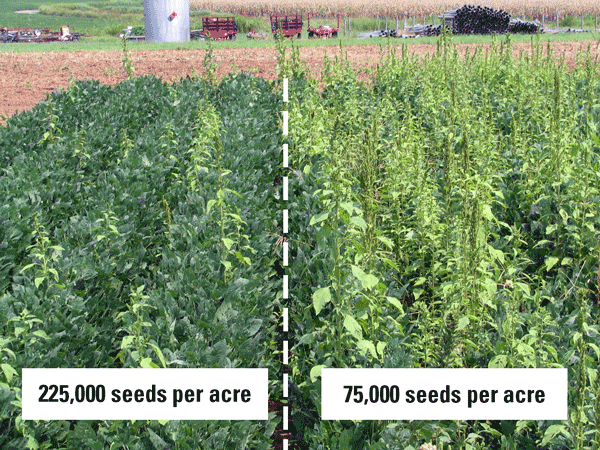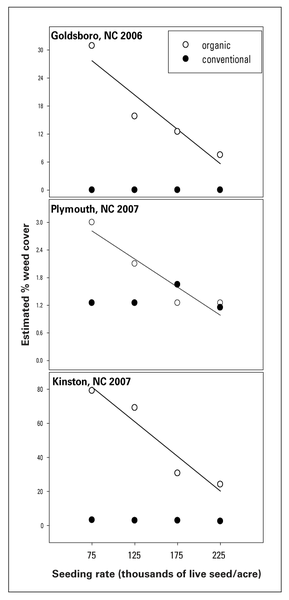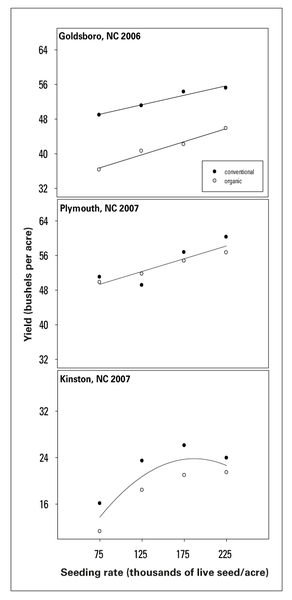There is demand of organic soybean production in North Carolina and the selling price for organic soybean can be more than twice that of conventionally managed soybean. However, weed infestations can dramatically reduce yield and discourage soybean producers from taking advantage of this market opportunity. Because synthetic herbicides are prohibited under organic production standards, organic soybean producers must rely on multiple tactics to control weeds. Increased soybean seeding rates are a tactic for organic soybean producers to improve crop competitiveness and enhance weed control.
Results of seeding rate research in conventional North Carolina soybean production, located in the North Carolina Soybean Production Guide, demonstrated over many environments that soybean yield does not significantly increase with plant densities exceeding 75,000, 90,000 and 110,000 plants/acre with May, June, and July planting dates, respectively. This is the case in conventional production with herbicide use, but for organic soybean producers, increased seeding rates improve early soybean canopy density, which shades out weeds in the early stages of weed competition. Compared with the cost of genetically modified organism (GMO) seed technology fees, organic soybean producers can increase seeding rates with much less of a negative impact on economic return.
The NC State Organic Cropping Research program investigated the planting rates of 75,000, 125,000, 175,000, and 225,000 seeds/acre for soybean variety ‘Hutcheson’ (Maturity Group V) at three locations over two years.
High soybean planting rates improved weed control for the organically managed plots (Figure 1 and Figure 2). Conventionally managed plots were essentially weed free due to herbicide application. Thus, higher planting rates were not advantageous for controlling weeds. Weed pressures were very light in Plymouth, NC, in 2007; moderate in Goldsboro, NC, in 2006; and heavy in Kinston, NC, in 2007.
At all three locations, organic soybean yields were greatest with the highest planting rate of 225,000 seeds per acre (Figure 3). At the Goldsboro location, soybean yield with conventional weed management was greater than soybean yield with organic weed management. However, at the Kinston and Plymouth locations, organic and conventional soybean yields were not statistically different.
The observed yield response due to increased planting rates was unexpected for conventionally managed soybeans. It must be noted that such results are contradicted by years of small-plot trials conducted in North Carolina and the response of soybean yield to seeding rate is variable depending on soybean planting date.
Although no soybean lodging was observed in this study, it could become an issue at higher soybean planting rates.
For more information, visit “Chapter 5: Crop Production Management - Organic Soybeans” in the North Carolina Organic Commodities Production Guide.
Publication date: Jan. 1, 2010
Reviewed/Revised: May 6, 2022
AG-723
N.C. Cooperative Extension prohibits discrimination and harassment regardless of age, color, disability, family and marital status, gender identity, national origin, political beliefs, race, religion, sex (including pregnancy), sexual orientation and veteran status.



